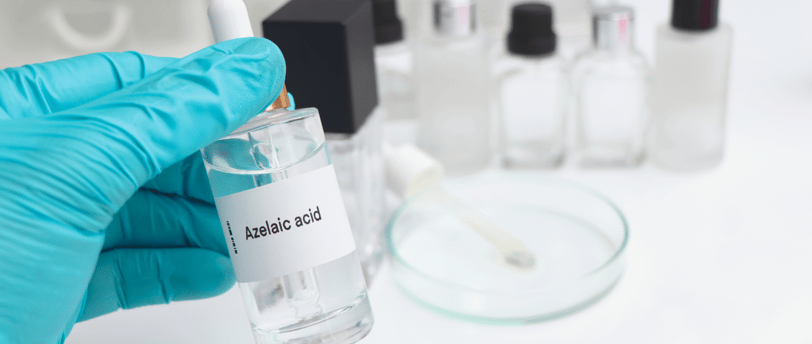
Transform Your Skin with Azelaic Acid: A Comprehensive Guide
SKIN CARE
7/25/20244 min read


When it comes to skincare, finding the right ingredients that work for our skin type can be a game-changer. One such ingredient gaining popularity is azelaic acid. Known for its versatility and effectiveness, azelaic acid is a powerhouse in dermatology. Much like hyaluronic acid, azelaic acid is naturally occurring in your skin, meaning your skin is familiar with and tolerates it well. Azelaic acid skincare products are genuine multi-taskers, helping with acne, rosacea, and hyperpigmentation, to name a few. Read on to find out what azelaic acid is, its numerous benefits for your skin, and how to incorporate it into your skincare routine.
What is Azelaic Acid?
Azelaic acid is a naturally occurring compound found in grains like barley, wheat, and rye. It is also produced by a type of yeast that lives on the skin. In the world of skincare, azelaic acid is renowned for its anti-inflammatory and antibacterial properties. It’s often used in the treatment of various skin conditions, making it a versatile addition to many skincare regimens.
Benefits of Azelaic Acid
Azelaic acid offers a multitude of benefits for the skin, making it a favored ingredient among dermatologists and skincare enthusiasts alike. Here are some key benefits:
Treats Acne: Azelaic acid helps to unclog pores and reduce inflammation, making it an effective treatment for acne. Its antibacterial properties also target the bacteria that cause acne.
Reduces Hyperpigmentation: It can lighten dark spots and melasma by inhibiting tyrosinase, an enzyme involved in the production of melanin.
Anti-Inflammatory Properties: This makes it beneficial for conditions like rosacea, where inflammation is a significant concern.
Exfoliates Gently: Unlike some harsher acids, azelaic acid provides gentle exfoliation, removing dead skin cells and promoting a smoother complexion.
Improves Skin Texture: Regular use can lead to a more even skin tone and refined skin texture.
Who Should Use Azelaic Acid?
Azelaic acid is suitable for a wide range of skin types and concerns, making it a versatile ingredient. Here's a breakdown of who might benefit from using it:
Acne-Prone Skin: Its ability to reduce inflammation and bacteria makes it ideal for those struggling with acne.
Sensitive Skin: Because it's less irritating than many other acids, it’s a good option for those with sensitive skin.
Unclogs Pores: It keeps pores clear and helps mitigate blackheads.
Hyperpigmentation Issues: If you have melasma or post-inflammatory hyperpigmentation, azelaic acid can help lighten these dark spots.
Rosacea: Its anti-inflammatory properties make it beneficial for those with rosacea.
When Should One Use Azelaic Acid?
Incorporating azelaic acid into your skincare routine can depend on your specific skin concerns. Here’s a general guide on when to use it:
Morning Routine: Azelaic acid can be applied in the morning to help protect the skin throughout the day. Follow it with a broad-spectrum sunscreen to protect your skin from UV rays, which can worsen hyperpigmentation.
Evening Routine: It can also be used in the evening, allowing it to work overnight to calm inflammation and improve skin tone. Ensure it's applied after cleansing and before moisturizing.
How to Incorporate Azelaic Acid into Your Skincare Routine
To get the most out of azelaic acid, follow these steps:
Cleanse: Start with a gentle cleanser suited to your skin type.
Toner: (Optional)
Apply Azelaic Acid: Use a product containing azelaic acid. This can be in the form of a cream, gel, or serum.
Moisturize: Follow up with a hydrating moisturizer to keep your skin balanced.
Protect: In the morning, always finish with a sunscreen of at least SPF 40.
Also read - Pairing Azelaic Acid with Other Ingredients
Side Effects of Azelaic Acid
Azelaic acid's most common side effects are dryness and irritation, which usually disappear after a few weeks. With a pH between 4 and 5, it closely matches the skin's natural pH, making it safe and well-tolerated. Adjusting the frequency of use can minimize any discomfort. Depending on skin sensitivity, you can apply it once or twice a day, or every other day.
What Not to Do with Azelaic Acid
Azelaic acid, like retinol, requires consistent use for maximum benefit. Daily application is essential for managing issues like clogged pores, redness, and pigmentation. Sporadic use will not provide the desired results.
How Long Does It Take for Azelaic Acid to Fade Hyperpigmentation?
You can see initial improvements in hyperpigmentation within six weeks of using azelaic acid, but full clearance may take six months or more. Consistent twice-daily use is key. Always apply a broad-spectrum sunscreen, ideally tinted with iron oxides, to protect against UVA1 and visible light.
Recommended Products
Glytone Enhance Brightening Complex
It helps brightens Skin & reduces Dark Spots.
Key Ingredients: 12% Azelaic Acid, 3% Glycolic Acid
Paula's Choice BOOST 10% Azelaic Acid Booster Cream Gel
Works on brown spots caused by sun damage, help reduce breakouts and diminish red marks
Key Ingredients: 10% azelaic acid, 0.5% salicylic acid
Versed Weekend Glow Daily Brightening AHA Liquid Exfoliant
Exfoliating and focused treatment for pigmented spots and dark spots from acne.
Key Ingredients: 0.5% azelaic acid, Vitamin C, Kojic Acid, and AHAs (2% lactic acid, 3% glycolic acid)
Cos De BAHA Azelaic Acid 10% Facial Serum
It improves skin clarity, reduces redness and texture
Key Ingredients: Azelaic Acid – 10%, Niacinamide, Hyaluronic Acid, Panthenol (Vitamin B5)
Azelaic acid is a versatile and effective ingredient that can benefit a wide range of skin types and conditions. Whether you're dealing with acne, hyperpigmentation, rosacea, or simply want to improve your skin texture, azelaic acid could be a valuable addition to your skincare routine. Always consult with a dermatologist to tailor the best approach for your skin's needs and to avoid any potential irritation. With consistent use, azelaic acid can help you achieve clearer, brighter, and more even-toned skin.
Also read - Pairing Azelaic Acid with Other Ingredients


